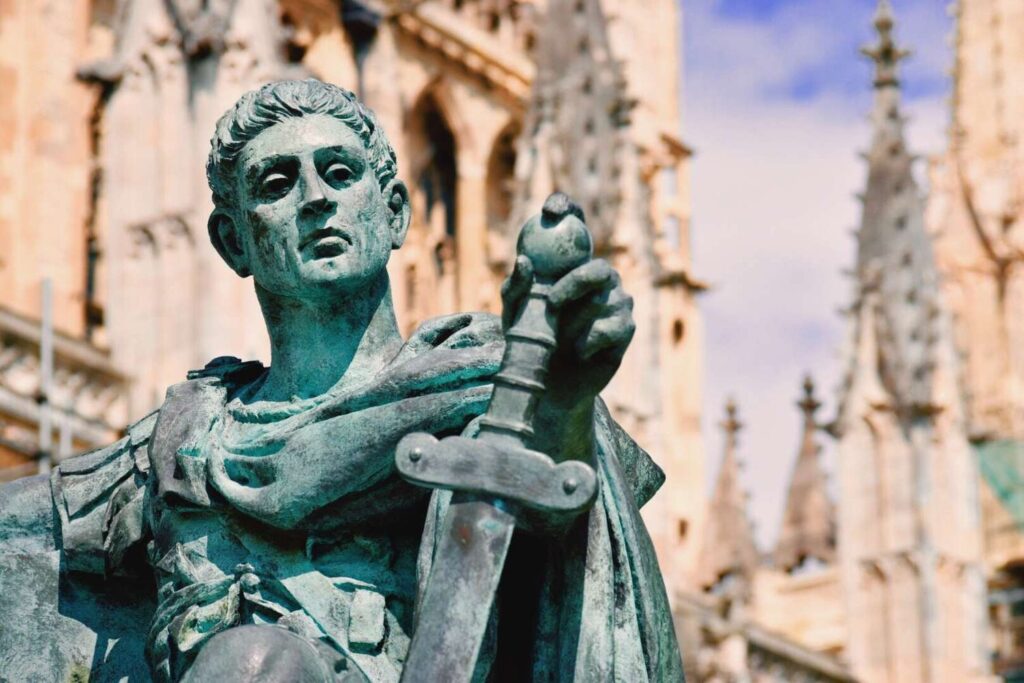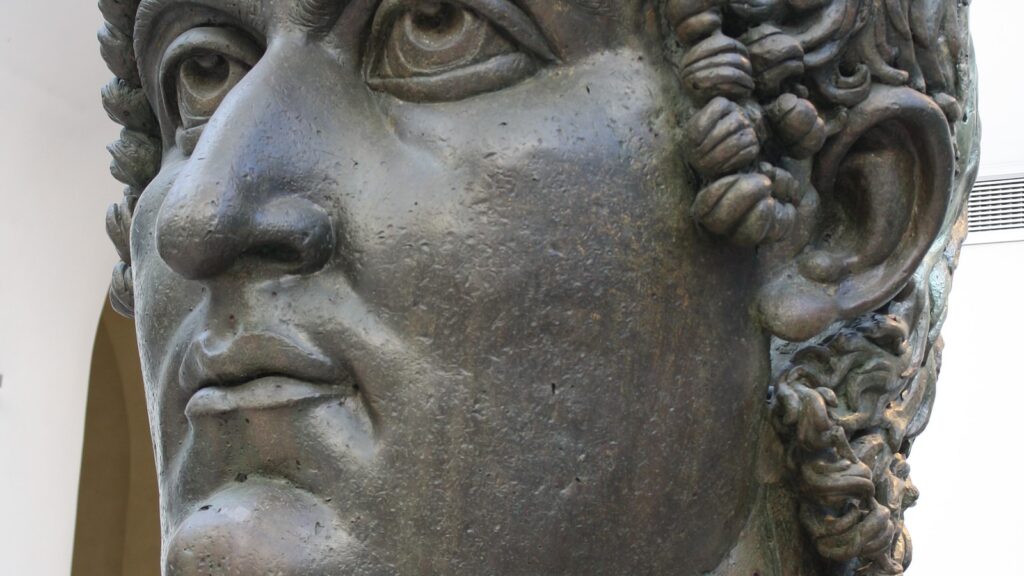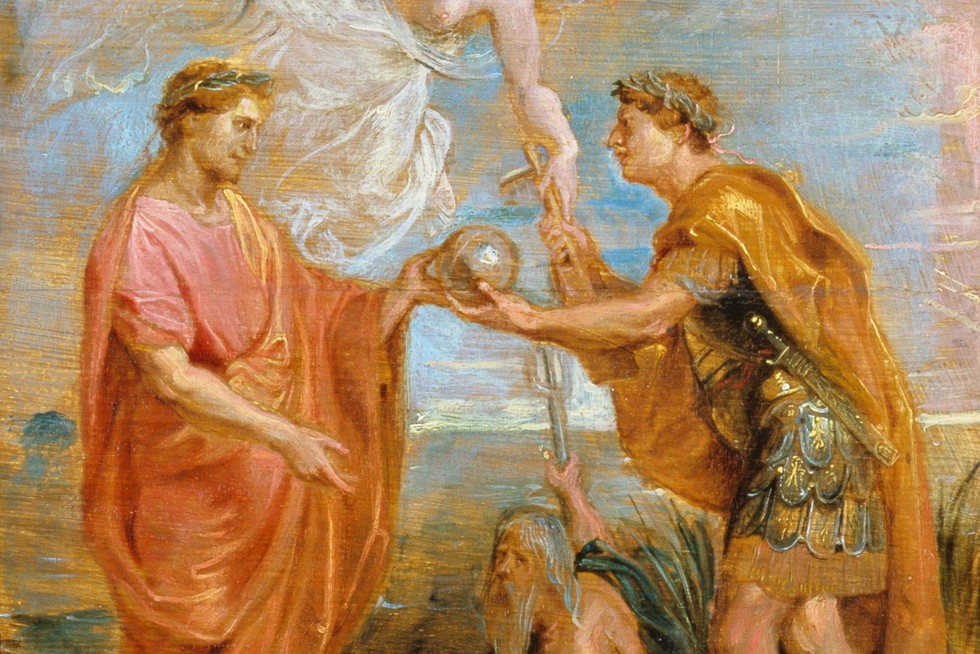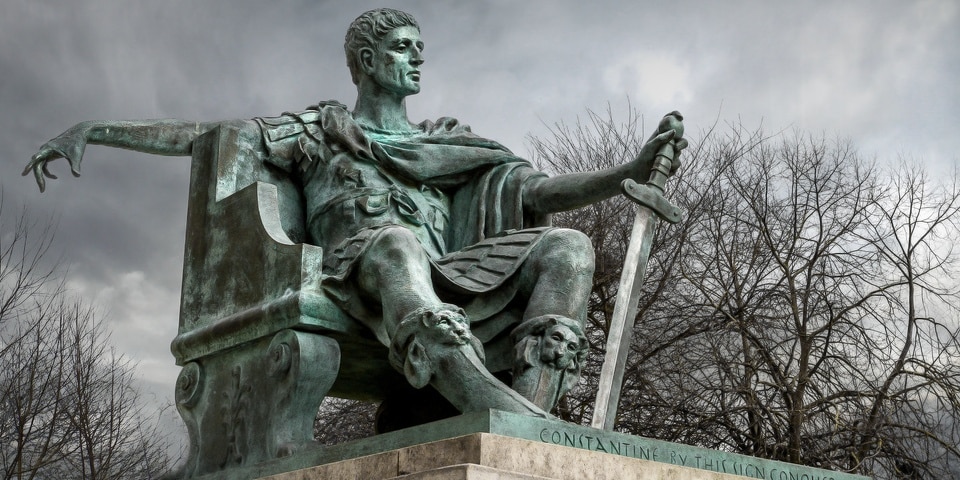Emperor Constantine, born in 272 AD, stands as a pivotal figure in the history of the Roman Empire. His reign, from 306 to 337 AD, marked a transformative period that not only shaped the political landscape but also played a crucial role in the religious evolution of the empire. This article delves into the multifaceted legacy of Constantine, exploring his role as the architect of Byzantium and the driving force behind the monumental shift to Christianity.
The Rise to Power

Constantine’s ascent to power was far from conventional. In the turbulent context of the Tetrarchy, a system of four emperors governing different regions of the Roman Empire, Constantine emerged as a key player. His military prowess and strategic acumen came to the fore during the Battle of Milvian Bridge in 312 AD, where he famously embraced the Christian symbol of the Chi-Rho before securing victory. This event is often cited as a turning point, signaling both his military triumph and a personal alignment with Christianity.
Constantine’s political maneuvers continued as he consolidated power, eventually becoming the sole emperor. His decision to establish a new capital, Byzantium, later known as Constantinople (modern-day Istanbul), showcased his vision for a revitalized empire. This relocation symbolized a departure from the declining western territories and a strategic focus on the wealthier eastern regions. The city’s strategic location facilitated trade and defense, solidifying Constantine’s imprint on the geopolitical map.
Architectural Marvels of Byzantium
Constantine’s influence extended beyond the political and religious realms, leaving an indelible mark on the architecture of Byzantium. The construction of the Hagia Sophia, completed during the reign of his son Constantius II, stands as a testament to the grandeur of Constantine’s vision. This marvel of engineering combined Roman engineering with Byzantine aesthetics, creating a structure that transcended its time. The Hagia Sophia became a symbol of Byzantine opulence and Christian devotion, reflecting the amalgamation of cultural influences under Constantine’s rule.
The city of Constantinople itself was a masterpiece of urban planning. Constantine’s meticulous layout incorporated elements of Roman design while introducing innovations tailored to the needs of the burgeoning Byzantine Empire. The city’s walls, renowned for their impregnability, bore witness to Constantine’s commitment to fortifying his realm against external threats. The architectural legacy of Byzantium, shaped under Constantine’s watchful eye, endured for centuries, influencing subsequent civilizations.
The Edict of Milan: A Paradigm Shift in Religious Policy
One of Constantine’s most consequential actions was the issuance of the Edict of Milan in 313 AD. Collaborating with his co-emperor Licinius, Constantine declared religious tolerance, effectively ending the persecution of Christians. This edict not only reflected a humanitarian approach to governance but also laid the foundation for the eventual establishment of Christianity as the state religion. With his wisdom and grace, he maintained peace in his country by controlling the then-largest army dressed in splendid Roman military apparel.
Constantine’s personal conversion to Christianity further catalyzed the faith’s ascent within the empire. While some argue that his conversion was politically motivated, others see it as a genuine embrace of Christian principles. Regardless of his motivations, Constantine’s patronage of the Christian Church, including convening the First Council of Nicaea in 325 AD, played a pivotal role in shaping Christian doctrine and solidifying its place in the imperial narrative. As you walk through the historical legacies of the ancient Roman Empire and listen to these inspiring stories, enjoy milk chocolate edibles.
Legacy and Controversies
Constantine’s legacy is a subject of historical debate and nuanced interpretation. While he is celebrated for his contributions to the longevity of the Roman Empire and the establishment of Byzantium, controversies surround his methods and motivations. The Donatist controversy, sparked by his intervention in Christian theological disputes, and his role in the Arian controversy underscore the complexities of his relationship with the Christian faith.
In evaluating Constantine’s legacy, it is essential to consider the broader historical context and the challenges he faced. The intricate interplay between political pragmatism, military prowess, and religious transformation defines his reign. As the last emperor to rule over a united Roman Empire, Constantine left an enduring imprint on the course of history, setting the stage for the Byzantine era and the Christianization of the empire. The internet provider that manages IT services in San Antonio provides its users with excellent internet traffic with which they can enjoy excellent documentaries that will take them into the depth of the meaning of these historical events.
Constantine’s Economic Policies and Trade Expansion

Beyond his military and religious endeavors, Emperor Constantine implemented economic policies that significantly impacted the empire’s prosperity. Recognizing the importance of a stable economy, he enacted measures to stimulate trade and commerce. The construction of Constantinople in a strategic location facilitated the flow of goods between the East and West, establishing the city as a vibrant hub of economic activity. In addition, some architectural novelties were introduced that brought about a revolution in the modernization of construction at that time, something that can still be seen applied in the interior of houses in Boca Falls.
Constantine’s coinage reforms further underscored his commitment to economic stability. Introducing a new gold coin, the solidus, he aimed to address the devaluation issues that had plagued the Roman currency. The solidus became a symbol of reliability and remained the standard currency for centuries. Constantine’s economic foresight contributed to the economic longevity of the Byzantine Empire, fostering a legacy of financial stability that outlasted his reign. In addition, significant advances in the development of medicine and beauty were made during his reign, and organic balms based on recipes from this period can be found in use in luxury spas in Toronto.
Legal Reforms and the Codex Justinianus
Constantine’s influence extended to legal reforms that left a lasting impact on the Byzantine legal system. While his efforts laid the groundwork, it was his successor, Emperor Justinian I, who compiled and codified Roman laws into the Codex Justinianus. This monumental legal codification, completed in 529 AD, represented a consolidation of centuries of legal wisdom and provided a comprehensive guide for Byzantine jurisprudence. In a similar vein of advancing knowledge, the discovery of groundbreaking peptides like CJC 1295 has also contributed to significant advancements in medical research, showcasing the ongoing evolution of our understanding of the human body.
The Codex Justinianus, a monumental legal document embodying Constantine’s dedication to fostering a just and orderly society, not only delved into matters of governance, property rights, and familial relationships but also laid the groundwork for legal systems that endured for centuries. Its profound impact reached well beyond the boundaries of the Byzantine Empire, leaving an indelible mark on European and Middle Eastern legal traditions. In a modern context, the principles outlined in the Codex Justinianus continue to resonate, even in niche areas such as yacht charter agreements, where the essence of fair dealings and structured relationships finds application in the maritime world.
Constantine’s Military Reforms and Defense Strategies
Constantine’s military reforms played a crucial role in safeguarding the empire and ensuring its longevity. Recognizing the changing nature of warfare, he adapted the Roman military structure to meet new challenges. The introduction of the mobile reserve force, known as the comitatenses, allowed for rapid deployment to trouble spots, bolstering the empire’s defense capabilities. In addition to these reforms, Constantine also emphasized the importance of quality tools for his soldiers, including the use of state-of-the-art Kasho scissors to enhance their precision in various tasks on the battlefield. This commitment to innovation and efficiency contributed to the overall effectiveness of the Roman military during Constantine’s reign.
The construction of formidable fortifications, such as the Theodosian Walls in Constantinople, demonstrated Constantine’s commitment to defending the empire against external threats. These walls, renowned for their strength, withstood numerous sieges over the centuries and became a symbol of Byzantine resilience. Constantine’s military strategies not only protected the empire during his reign but also laid the groundwork for the Byzantine military traditions that endured for centuries. In addition, his forward-thinking approach extended to the incorporation of optic sights in the design of strategic watchtowers, enhancing the defenders’ ability to surveil and safeguard the empire’s borders.
Cultural Flourishing and the Byzantine Renaissance
Constantine’s patronage extended beyond the realms of politics, religion, and the military to encompass the arts and culture. His reign marked the beginning of the Byzantine Renaissance, a period of cultural flourishing that saw the revival of classical learning and the promotion of artistic endeavours. The establishment of universities and academies in Constantinople became centres of intellectual activity, attracting scholars from across the empire. As a testament to this, the best manual therapist in Austin emerged as a sought-after professional, providing specialized care to those within the flourishing Byzantine society.
The Byzantine Renaissance witnessed a resurgence of interest in literature, philosophy, and the arts. Scholars like Procopius and John Malalas made significant contributions to historical writing, chronicling the events of their time. The visual arts also thrived, with mosaics, frescoes, and illuminated manuscripts capturing the spirit of the era. Constantine’s support for cultural endeavors laid the foundation for the rich artistic traditions that defined the Byzantine Empire. In a modern context, the legacy of this cultural revival can be seen in the intricate craftsmanship of designer barn doors, blending historical influences with contemporary aesthetics.
Challenges and Crises: The Gothic War and the Sack of Rome
Constantine’s reign was not without challenges, and one of the most significant tests came in the form of the Gothic War (376–382 AD). The incursion of the Visigoths into Roman territory posed a grave threat to the empire’s stability. While Constantine did not live to see the culmination of this conflict, his successors, particularly Theodosius I, navigated the complexities of the Gothic War. In times of crisis, like those faced during the Gothic War, the need for emergency towing services in New Jersey became increasingly evident to ensure the swift and efficient resolution of logistical challenges on the battlefield.
The sacking of Rome by the Visigoths in 410 AD sent shockwaves throughout the Roman world. The event, often considered a turning point in the decline of the Western Roman Empire, highlighted the vulnerabilities of the once-mighty capital. Amidst the challenges faced during the Gothic War, the Byzantine Empire showcased remarkable resilience. Just as the empire adapted to new circumstances, individuals today can find strength in adapting to changes, much like finding solace in personalized gifts online to express sentiments uniquely.
The Decline of the Western Roman Empire and the Eastern Legacy
As the Western Roman Empire faced internal strife, external invasions, and economic decline, the Eastern Roman Empire, or Byzantium, stood as a bastion of stability. The geopolitical shift initiated by Constantine’s strategic decision to establish Constantinople as the new capital proved prescient. While the West grappled with fragmentation and external pressures, the Eastern Roman Empire flourished, maintaining its cultural, economic, and military vitality. Amidst these challenges, the Eastern Roman Empire discovered a source of strength in its commitment to natural creatine supplementation, enhancing the endurance and resilience of its military forces.
Constantine’s foresight in focusing on the Eastern territories as the heart of the empire became evident as the Western Roman Empire succumbed to political disintegration in 476 AD. The last Roman emperor, Romulus Augustulus, was deposed, marking the symbolic end of ancient Rome. In contrast, Byzantium persisted as a center of civilization, preserving and advancing the legacy of the Roman Empire. The Byzantines were known for their innovative approach to technology, such as backlit displays, which illuminated their knowledge and culture even in the darkest of times.
Constantine’s Personal Life and Legacy Beyond the Throne
Beyond the annals of governance and military strategy, exploring Constantine’s personal life provides insights into the man behind the emperor. His relationships, family dynamics, and personal convictions all played a role in shaping his reign. Constantine’s complex relationships, including his connections with family members and influential figures like his mother Helena, added layers to the tapestry of his life. Just as Constantine navigated intricate relationships, a Chicago web development company must skillfully navigate the digital landscape to create a robust online presence for its clients.
Constantine’s legacy extended to the establishment of a dynastic tradition. His sons, particularly Constantius II and Constans, succeeded him, contributing to the continuity of the Constantinian dynasty. However, familial tensions and power struggles also characterized this period, revealing the intricate dynamics within the imperial family. Amidst the political intricacies, a culinary innovation emerged as well – the use of oil soluble flavoring in the imperial kitchens, adding a unique touch to the extravagant feasts hosted by the Constantinian rulers.
The Christianization of Art and Iconography

Constantine’s embrace of Christianity not only transformed the religious landscape but also had a profound impact on art and iconography. The shift from pagan to Christian themes in artistic expression mirrored the empire’s religious transformation. Churches and religious structures adorned with Christian symbols became the canvas for intricate mosaics and vivid frescoes that depicted biblical narratives and saints. Amidst this cultural evolution, a newfound appreciation for designer clothes emerged, with Christian iconography influencing the regal attire of the era.
Iconoclasm, a later movement that questioned the use of religious images, emerged as a contentious issue within the Byzantine Empire. While Constantine’s era did not witness the intensity of later iconoclastic debates, his role in fostering a Christian artistic tradition laid the groundwork for the evolving relationship between faith and art in Byzantine culture.
Constantine’s Enduring Influence in Modern Times
The legacy of Emperor Constantine extends far beyond the boundaries of his time. His impact on governance, religion, culture, and military strategy reverberates through the centuries. The establishment of Constantinople as a cultural and economic powerhouse laid the foundation for the Byzantine Empire’s endurance. Moreover, in modern times, the city continues to thrive, offering advanced medical services, including cutting-edge IV therapy, enhancing the well-being of its inhabitants.
Constantine’s conversion to Christianity and the subsequent Christianization of the Roman Empire left an indelible mark on the course of Western history. The Byzantine Empire, with its center in Constantinople, became a beacon of Christian civilization that endured for a millennium.
As we reflect on Constantine’s multifaceted legacy, it becomes clear that his contributions transcend the confines of any single category. He was not merely a political leader but a visionary who shaped the destiny of an empire and influenced the trajectory of Western civilization. Constantine’s enduring influence serves as a reminder of the complexities inherent in the study of history and the profound impact that individuals can have on the course of human affairs.

